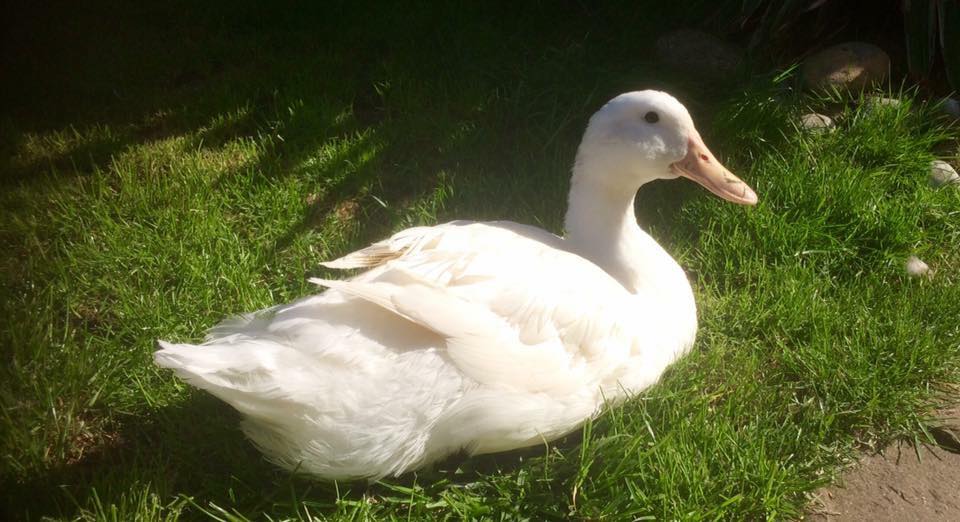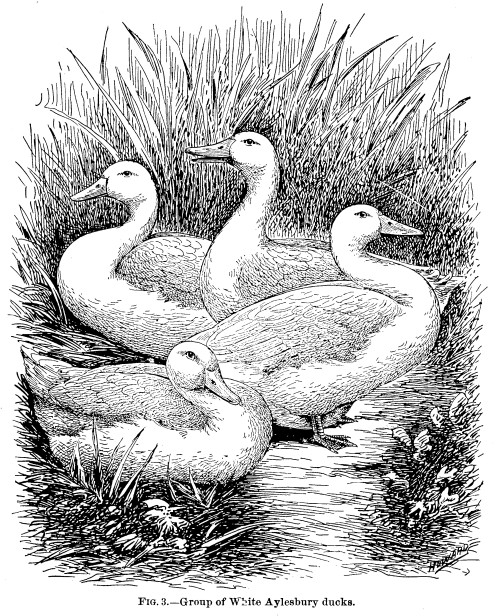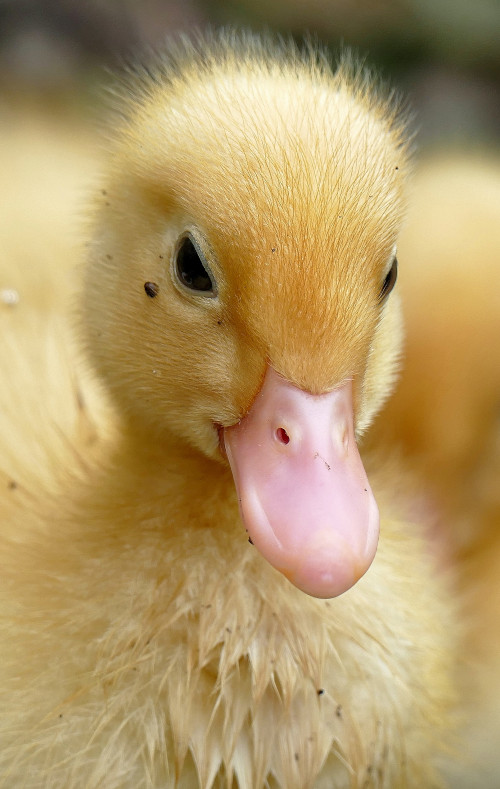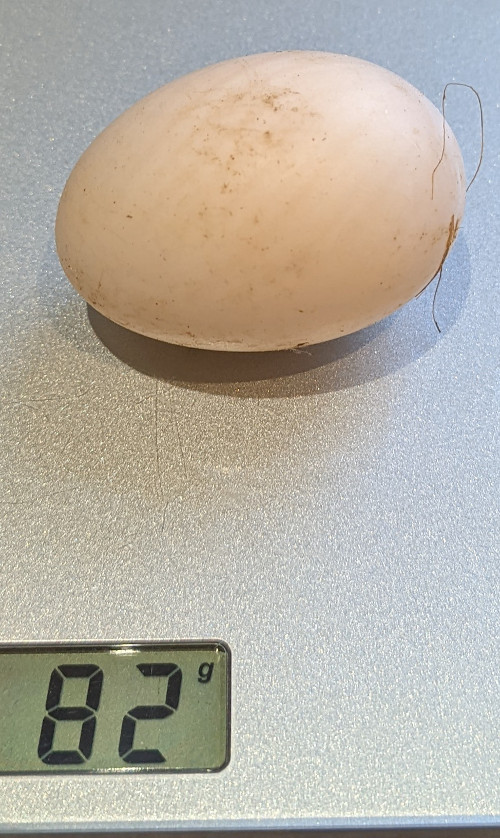The Aylesbury duck.

Aylesburys are one of our common domestic ducks - seen for 150 years or more around the farmyards of middle England from whence they spread around the country.
Table of Contents
- A brief history of Aylesbury ducks:
- How big are Aylesbury ducks?
- Are Aylesbury ducks friendly?
- Do Aylesbury ducks lay eggs?
- Are Aylesbury ducks rare?
- Do Aylesbury ducks need a pond?
- What's the lifespan of an Aylesbury duck?
- Where to get Aylesbury ducks and how much to pay for them:
- Aylesbury duck breed standard:
- Aylesbury ducks for meat:
The plumage of the Aylesbury duck should be pure white, with a pink bill and bright orange feet and legs. The pink bill colour is a key characteristic of the breed.
A brief history of Aylesbury ducks:
Origin: Aylesbury, Buckinghamshire, Great Britain. The Aylesbury duck is the heraldic emblem of the town of Aylesbury.
Below: A portrait of Aylesbury ducks from an old poultry book.

As with the majority of our domestic ducks, except the Muscovy, the Aylesbury is derived from the Mallard, one of the genetic strains that breeders has manipulated over the centuries to stabilise a large white duck, which had great egg laying ability as well as good meat quality.
The Aylesbury duck was bred in the 1800's and much of the 1900's.
Records of the first poultry show in 1845 show classes for 'Aylesbury or other white variety' and for 'Any other variety'. Since that date the particular characteristics of the breed were standardised and selected for to create a good meaty bird. Later the standard diverged so the exhibition quality bird is now very different to that of the utility.
How big are Aylesbury ducks?
Ayles ducks are large and full bodied and classed as heavy.
Aylesbury drakes weigh between 10-12 lbs or 4.5 to 5.5 kg, and the ducks (females) should be 9-11 lbs or between 4 and 5kg.
Below: Aylesbury duck breed video.
Aylesbury should have a horizontal carriage and a somewhat square shape with the breast of the bird coming parrallel to the ground when stood.
Are Aylesbury ducks friendly?
My Aylesbury ducks are fine pets and lazy, eating machines who enjoy their pond. Hand reared birds are extremely friendly.
Below: Hand reared ducklings are very friendly and make good pets.

They can get a little fat if allowed to feed all the time and benefit from being free range.
Do Aylesbury ducks lay eggs?
Aylesbury ducks lay a large white egg and will produce around 150 eggs a year.
Below: Here is me collecting eggs from my Aylesbury ducks.
Aylesbury ducks start laying at between 20 and 28 weeks or 5 to 7 months of age. Ducklings hatched later in the year will take longer till they produce eggs while early spring ducklings will start to lay by October or November.
Below: My Aylesbury duck eggs weigh an average of 82 grams or 2.9 ounces. Here is one on the scales.

Aylesbury ducks lay 3 to 4 eggs per week in season. Mine produced 141 eggs each on average last year.
Are Aylesbury ducks rare?
Quality Aylesbury ducks remain a rarity, as a heavy breed they are expensive to keep.
In his book from 1897 George E. Howard Said of the Aylesbury duck:
"The advantages claimed for Aylesbury ducks are the ease with which it is acclimated, thriving in every country and climate; its early maturity; its great hardiness; its large size; its great prolificacy, and the real beauty which it possesses."
Do Aylesbury ducks need a pond?
All ducks fare better with water and Aylesburys are no exception. Ducks kept without access to water can have foot problems and fertility issues. It does not have to be a pond but should be deep and large enough for them to submerge in.
Ducks need a supply of fresh water at all time for bobbing their heads in as well as swimming.
Water helps ducks keep their feathers, eyes and bills clean as well as helping them eat dry foods like pellets.
What's the lifespan of an Aylesbury duck?
My Aylesbury ducks live an average of 9 years and are productive egg layers for around 5 or 6 years.
Egg numbers decline by around 15% for every year of age.
Where to get Aylesbury ducks and how much to pay for them:
You will only be able to get genuine Aylesbury ducks form a breeder.
Try Facebook groups and the breed society for leads.
Expect to pay £5 ($8) each for Aylesbury duck hatching eggs, £10 ($16) each for ducklings and at least £50 ($70) each for fully grown birds.
I paid £350 or nearly $500 for 2 drakes and 5 ducks at 20 weeks old.
Aylesbury duck breed standard:
The head of the Aylesbury duck is long and neatly formed; the eyes of a deep leaden-blue colour and the long, wide bill is of a pale flesh colour or pinkish hue, and should be free from dark spots.
Bills marked with black being a disqualification. The neck is slender, long, and gracefully curved; the body is long and oval; the breast is full and round; the strong shanks are of brilliant light-orange colour; the wings are strong and nicely folded; the back is both long and broad, and the tail formed of stiff, hard feathers
The soft white plumage is one of the chief attractions of the Aylesbury breed, and like most white plumage has a tendency to assume a yellow hue if exposed to the sun. The beak will also lose its delicate pink hue and become yellow if exposed to too much sunlight in summer.
Aylesbury ducks for meat:
The attraction of the Aylesbury for development as a table bird was its large frame, which careful selective breeding would fill with meat.
Equally importantly its white feather and skin. The white feather stubs leave less of an obvious residue after plucking so making the resulting carcass much more attractive to the general market.
The old utility types were very efficient converters of feed to meat with a less pronounced bony keel than exhibition stock. It is said that at 8 weeks they would be at their best, weighing around 4-5 lbs.
You will need to ask the breeder what weights their birds have at this age to compare the strains available to you. The results you get will depend entirely on what selection has taken place in the past 5 generations.
From our experience so far their main activity is eating - and if their breeding is right, they will convert food into meat at an amazing rate. In fact one has to be careful with young birds that they don't over do it. If you keep the youngsters free range, and do not feed ad-lib they do very well.